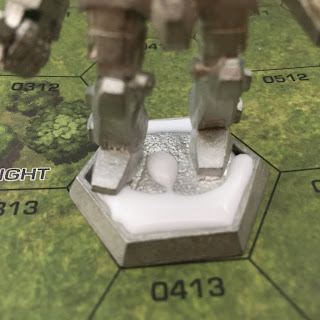My nearest and dearest fictional universe has been BattleTech for many years now. You wouldn't be able to tell by this blog, but I've been invested in the Inner Sphere, the Clans, the Star League since the cartoon got me in 1994. No matter what other game line or alternate interest sinks it's hooks in, I always come back to the one I love.
Today, I'd like to present a few pieces from the various Clan factions. Descendants of the fallen Star League's vast army, a ruinous civil war forced a change upon this society into what the Inner Sphere would later dread as the Clans.
First off, a Dire Wolf test piece for Clan Jade Falcon's Turkina Keshik, an elite unit that serves as both a bodyguard formation to the Clan's Khan and as a tactical strike force. This unit took part in far more planetary invasions in the initial Clan Invasion, called Operation REVIVAL, than I realized previously, including a fight against the Grey Death Legion, my favorite mercenary group. One of the least fun aspects of this paint scheme is that it calls for falcon murals to be prominent on all machines, which is not something that's really in my wheelhouse. My vision isn't always the greatest, but I think I managed. I have a spare Star of plastic OmniMechs from the recent Kickstarter that I am trying to talk myself out of painting in Turkina Keshik colors.
 |
| This was the example to go by, from an Alpha Strike stat card. I kinda wish I'd gone with a lighter turquoise color on my Dire Wolf |
Next, a Clan that is truly near and dear, the Smoke Jaguars! Easily the most brutal of the Invading Clans, the Jaguars never did much for me until I read of their destruction in 3060 at the hands of a multinational Inner Sphere offensive. For some reason, I've been all-in on them since then. These are works-in-progress from the Smoke Jaguar Beta Galaxy, and are all new plastic miniatures from the Kickstarter, specifically the Clan Command Star.
 |
| The white spots on either sides of the cockpit are going to be yellow felinid eyes, in keeping with the official scheme. |
These are packed with details and are a joy to paint! Beta Galaxy uses shades of grey to represent a 'banks of mist' effect, so I tried to soften the appearance of some of the lighter grey stripes in some areas while leaving them more distinct in other spots. Beta is not the most successful Galaxy, having captured and then lost Hohiro Kurita before they knew they had him, losing control of the city of Edo on Turtle Bay that resulted in that city being wiped off the map by orbital bombardment, walking into the trap on Wolcott, and becoming mired in the Racice Delta on Tukayyid and failing to capture their objective. They also took part in the failed invasion of the Draconis Combine's capital of Luthien alongside Clan Nova Cat. But I like the scheme, and some of the earliest works to talk about the Jags (like the Luthien scenario book) mention the Jaguar Guards Clusters (of which there were two, both in Beta) in ways that suggest they were the early big-bads of the Clan, before the likes of the Jaguar Grenadiers or those pansies in the 6th Jaguar Dragoons were fleshed out.
Much more to come!



















